What we know is that aluminum is extremely difficult to weld.
It is a soft metal and is a sensitive subject to warping due to high heat. So one needs a steady hand and experience when welding aluminum. Some would also emphasize the usage of a good welding machine as well.
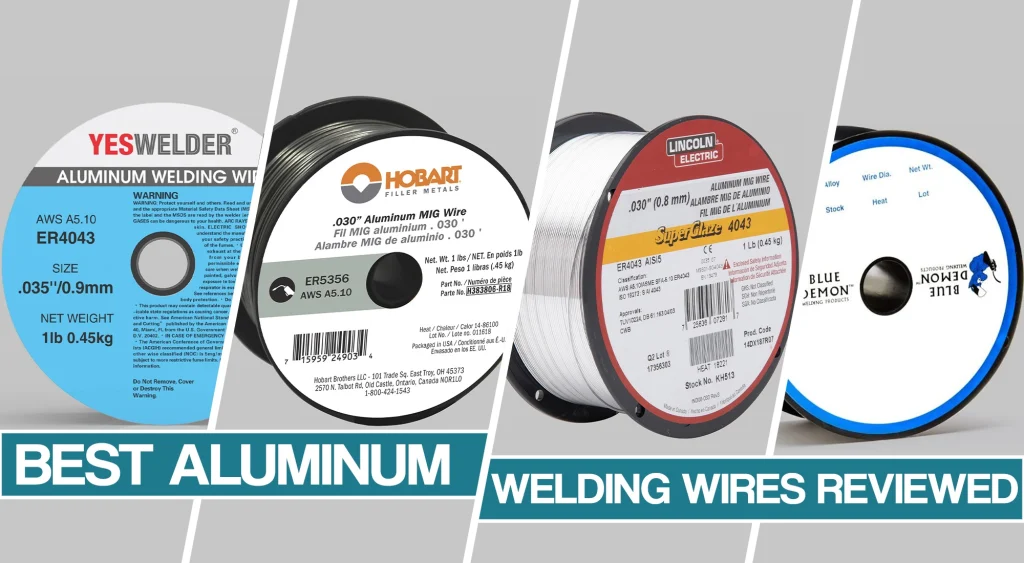
However…
What also needs to be taken into consideration is the type of aluminum welding wire. Welder aluminum can become much easier if you use an adequate aluminum filler.
General-purpose aluminum wire is not going to do the trick all the time.
So in order to help you understand which one works best, we present to you the aluminum wire needed to successfully MIG weld aluminum and also by using other types of welding processes.
Aluminum Welding Wire Comparison Table
| Image | Name | Specials | Type | Wire Diameter | Spool Size | Check Price |
|---|---|---|---|---|---|---|
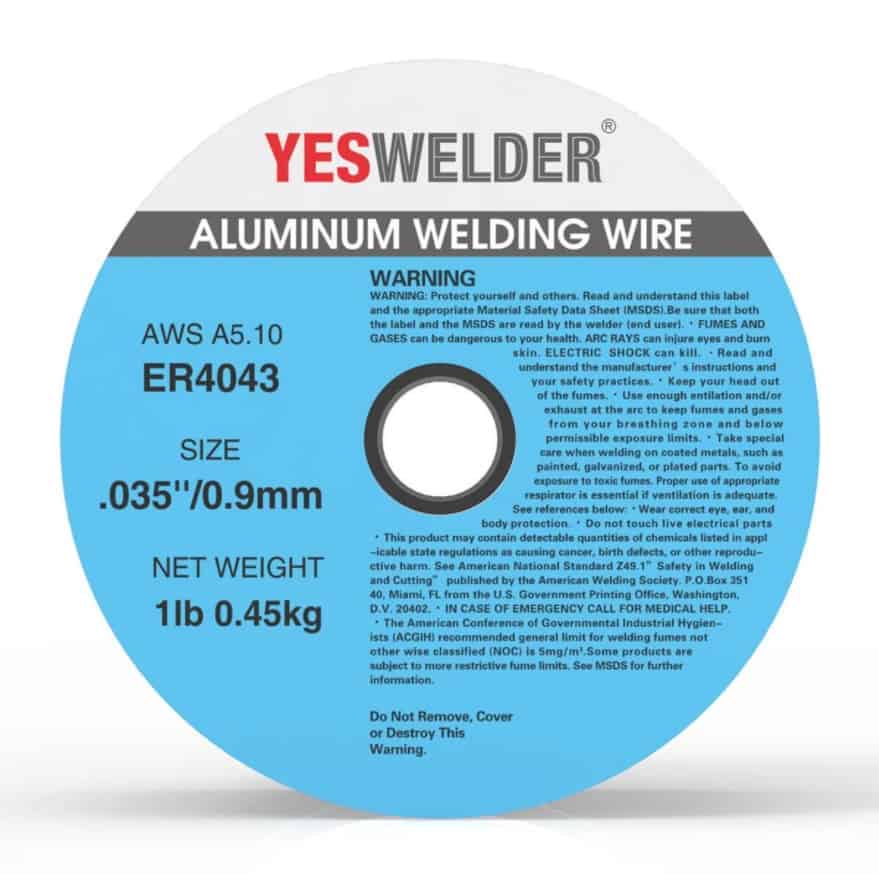 | YesWelder Silicon Aluminum Welding Wire | Get 10% Off With Coupon: “-10% WELDPROS” | ER 4043 Aluminum Wire | 0.035" | 1 lb | Check Current Price Yeswelder |
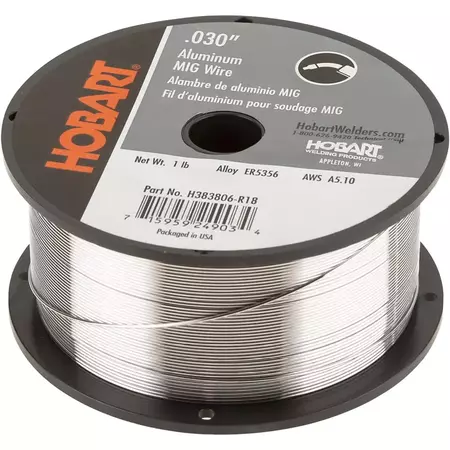 | Hobart H383806-R18 | Brand-name | ER 5356 Aluminum Wire | 0.030" or 0.035" | 1 lb | Check Current Price Amazon |
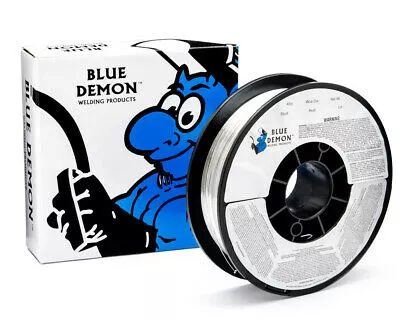 | Blue Demon ER5356 X | Great Value | ER 5356 Aluminum Wire | 0.035" | 1 lb | Check Current Price Amazon |
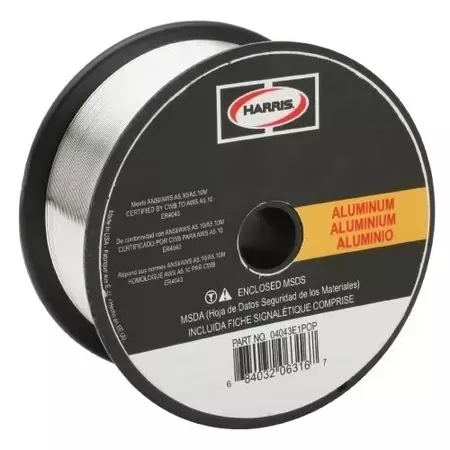 | HARRIS 05356F1 5356 | Good Reviews | ER 5356 Aluminum Wire | 0.035" | 1 lb | Check Current Price Amazon |
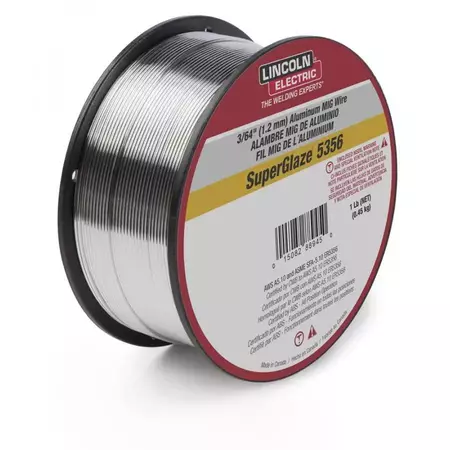 | Lincoln Electric 5356 Aluminum MIG Wire | Best For Lincoln Welders | ER 5356 Aluminum Wire | 0.035" | 1 lb | Check Current Price Amazon |
Best Aluminum Welding Wire Review
Welding aluminum will become easier with suitable aluminum metal wire. There are a few things that you have to consider first before you start welding aluminum.
The first thing to start with is cracking susceptibility, which could occur when the weld solidifies. The next thing that comes to mind is weld strength as it is really hard to obtain weld strength as strong as the base materials. Next are the aesthetics, as you would want to get clean aluminum welds. But some filler alloys can result in sooty residue on the surface, so a good choice needs to be made before starting everything. Also, you need to match the corrosive properties of the base metal with aluminum welding as well.
Considering the temperature is an important factor also as some alloys are susceptible to cracking when exposed to a temperature over 150 degrees. Also, determining the larger diameter wire for aluminum welding is an important nat piece of the puzzle as well. Finally, deformation under stress is also an issue and one has to think long and hard before choosing the best filler for welding aluminum.
Now when we have all of that out of the way consider our review of all the useful wires used for welding this type of soft metal.
1. YesWelder Silicon Aluminum Welding Wire
The YesWelder silicon aluminum wire is an ER4043 general-purpose aluminum filler wire. Since it contains silicon, it is characterized by having greater fluidity of the weld pool and for creating welds that are less prone to cracking. It can be used to weld various grades of aluminum making it popular among welders.
It contains 5% silicon, as any 4043 filler wire does, and is best used for the process of MIG welding. It is also capable of producing brighter welds, making it even more attractive to use.
It can be used aluminum grades such as 3003, 3004, 5052, 6061, and 6063, as well as casting alloys 43, 355, 356, and 214. Sold at 1 lb spool.
Pros & Cons Summarized
Pros
- The wire gives little splatter, and flows nicely
- Quality product, smooth bead
- Less sensitive to weld cracking than other aluminum alloys
- It can be used to weld various grades of aluminum
- The spool fits spool gun perfectly
Cons
- As others ER 4043 wires, post anodizing color can be a bit darker
Specifications
- Size: 0.035″ Diameter, 1 lb Spool.
- Type: Aluminum welding wire type ER4043.
- Manufacturer: YESWELDER.
- Melting Range: 1065 °F– 1170 °F.
- Density: 0.097 lbs/in3
- Tensile Strength: 27 ksi
- Usage: Used to weld various grades of aluminum, 3003, 3004, 5052, 6061, 6063, and casing alloys 43, 355, 356, and 214.
- Post Anodizing Color: Gray.
2. Hobart H383806-R18 Aluminum Welding Wire
The Hobart H383806-R18 is another general-purpose wire. It is an ER5356, meaning that it contains magnesium as an additive.
What makes the Hobart product stand opposed to the others is that possesses high shear strength and provides huge corrosion resistance. This is very useful for boat welding as you can freely expose the welds to saltwater.
Since it is an ER5356 wire, with it you can weld 5000 series aluminum base metal.
It comes in 0.030-inch or 0.035 diameter and 1 lb spool. It can actually also weld 5086 and lower strength alloys. It is most commonly used with MIG welding processes and most suitable for working on truck trailers, construction, and boat manufacturing. Furthermore, this welding wire supports various welding positions that include vertical, horizontal, flat, and overhead at a 10 to 15-degree angle.
Pros & Cons Summarized
Pros
- Relatively high shear strength
- General-purpose type aluminum alloy
- Offers excellent corrosion resistance when exposed to salt water
- Available as 0.030 and 0.035″ wire diameter
- Slightly brighter post anodizing color
Cons
- Plastic spool can get edges which need to be sanded
Specifications
- Size: 0.030″ or 0.035″ Diameter, 1 lb Spool.
- Type: Aluminum welding wire type ER5356.
- Manufacturer: Hobart.
- Melting Range: 1060 °F– 1175 °F.
- Density: 0.096 lbs/in3
- Tensile Strength: 38 ksi
- Usage: Used for welding 5000 series aluminum base metals, 5086 and lower strength alloys.
- Post Anodizing Color: White.
3. Blue Demon ER5356 Aluminum Welding Wire
The Blue Demon ER5356 is an all-purpose wire also chosen for its high shear strength. What makes it useful is its corrosion resistance properties, making it suitable for welds that will be exposed to saltwater. If choosing this welding wire know that with it you can weld 5000 series aluminum alloys.
It can be used at DCEP welding current and AWS A5.10. The size is 0.035 diameter at 1 lb spool.
Its primary usage is argon-arc welding of aluminum alloy. This welding wire allows for exceptional versatility that not a lot of similar products have. This one can also be used in various welding positions that include horizontal, flat, vertical, and overhead.
Pros & Cons Summarized
Pros
- Thin aluminum but very sturdy
- Great price for value
- Offers excellent corrosion resistance when exposed to salt water
- General-purpose type aluminum alloy
- Comes with a sticker for the tool box
Cons
- Not noted by manufacturer that this is not a gasless wire
Specifications
- Size: 0.035″ Diameter, 1 lb spool.
- Type: Aluminum welding wire type ER5356.
- Manufacturer: Blue Demon.
- Melting Range: 1060 °F– 1175 °F.
- Density: 0.096 lbs/in3
- Tensile Strength: 38 ksi
- Usage: Used for welding 5000 series aluminum base metals, 5086 and lower strength alloys
- Post Anodizing Color: White.
You need Argon shielding gas to use this welding wire. Learn more about welding gases here.
4. HARRIS 05356F1 MIG Welding Aluminum Wire
One of the good products to use when welding aluminum is the HARRIS 05356F1 MIG welding aluminum wire. It is an all-position non-heat-treatable MIG wire suitable for 5000 series aluminum base metal, but without 40, 000 psi tensile strength is a requirement. 5356 is one of the most used types of wires due to its versatile usage.
This filler metal for welding aluminum is mostly used for welding ships, trucks, bicycles, pressure vessels but some soft metal found in automotive parts as well.
It comes in 0.035 diameter and is qualified for AWS A5.10. It is sold at 1 lb spool. The HARRIS product is widely regarded within the market base and can also be used to weld in all positions.
Pros & Cons Summarized
Pros
- All position non-heat treatable MIG wire
- Very good all purpose wire
- Offers excellent corrosion resistance when exposed to salt water
- Most widely used of all aluminum fillers metals
- Good and clean wire which results in clean bead
Cons
- Spool hole is smaller than showed on picture
Specifications
- Size: 0.035″ Diameter, 1 lb spool.
- Type: Aluminum welding wire type ER5356.
- Manufacturer: The Harris Products Group.
- Melting Range: 1060 °F– 1175 °F.
- Density: 0.096 lbs/in3
- Tensile Strength: 38 ksi
- Usage: Used for welding 5000 series aluminum base metals.
- Post Anodizing Color: White.
5. Lincoln Electric 5356 Aluminum MIG Wire
The Lincoln Electric 5356 aluminum welding wire is meant for heavy-duty applications due to its strength. It is a general-purpose wire filler alloy for 5XXX series aluminum alloys. It is characterized by improved feedability and by having reduced shavings.
This welding wire is actually best used in very aggressive work environments. It is also more than good in long conduit lengths. Its main usage is in working on structural frames, mainly in the shipbuilding industry, welding automotive bumpers and support, railcars, trailers, and truck panels. But it is also more than useful in the power industry.
It can be combined with 100% argon gas shielding gas with a flow rate of 20 to 30 cubic feet per hour or mixed shielding gas. It comes at 0.035 diameter wire and 1 lb spool.
Pros & Cons Summarized
Pros
- General purpose filler alloy
- Very good all purpose wire
- Offers excellent corrosion resistance when exposed to salt water
- Supports Structural frames in the shipbuilding industry
- As other ER 5356 wires, has brighter post anodizing color
Cons
- Not that widely purchased
Specifications
- Size: 0.035″ Diameter, 1 lb spool.
- Type: Aluminum welding wire type ER5356.
- Manufacturer: Lincoln Electric.
- Melting Range: 1060 °F– 1175 °F.
- Density: 0.096 lbs/in3
- Tensile Strength: 38 ksi
- Usage: Used for welding 5000 series aluminum base metals.
- Post Anodizing Color: White.
Types of Aluminum and Aluminum Wire
So once you get your hand s on soft metal like aluminum, you have to take a different approach as towards other types of metal. So taking your time and choosing the correct wire used for welding is not a waste of time. There are different series aluminum wire but pure aluminum is not used as it is too soft to be used in casted parts. So in order to match the filler metal and stabilize the aluminum, other alloys are used. They are usually sold as 1 lb spool.
Both beginner and experienced welders will use a certain series aluminum alloy. The most common ones that you will definitely be using are the 4,000 Series, the 5,000 Series, and 6, 000 Series aluminum base.
The 4,000 series aluminum alloy has silicon added to it. the 5,000 aluminum series alloy has magnesium. But the 6,000 aluminum series alloy comes with both silicon and magnesium added to the mix.
Basically what you need to do when welding aluminum is to match the filler metal with the additive added to the aluminum alloys. The 4043 wire and the 5356 are the two best types of wires used for MIG welding aluminum.
ER 4043
The alloy 4043 wire is a general-purpose aluminum wire perfect for making brighter and shinier finishes. It includes silicon, making it a bit more forgiving to the person doing the work. However, this type of welder aluminum is going to produce welds that are more susceptible to cracking. It is usually used for 4,000 and 6,000 series aluminum alloys.
ER 5356
The 5356 is a welding wire that is, although more difficult to weld with, much stronger than the 4043 wire. Also, it is considered as the best wire to use as it has a wider array of usage. Even though this is a general-purpose aluminum wire it has found its usage in welding boats due to not being susceptible to saltwater. But it can also be used for fixing bicycles, car parts, or pressure vessels.
ER 4043 Vs. ER 5356
ER 4043
- Used for 4000 and 6000 series aluminum alloys.
- Aluminum filler with 5% silicon added.
- Darker weld post anodizing color.
- Suitable for service temperatures above 150 Deg, F.
- A softer alloy in the form of spooled wire,
- Generally tend to produce welds with improved cosmetic appearance.
- Will typically provide a higher rating for weldability and provide slightly lower crack sensitivity.
ER 5356
- Used for 5000 series aluminum alloys.
- Aluminum filler with 5% magnesium added.
- Brighter weld post anodizing color.
- Because of its 5% magnesium content is not suitable for these elevated temperature applications.
- Has more shear strength.
- Has higher ductility.
- Has higher corrosive and saltwater resistance, therefore used for welding boats.
Why buy Brand Name Aluminum Welding Wire
There are plenty of reasons why choosing brand name wires is better than buying cheap, off-brand stuff. You might come across some wire which is damaged. Some have even used wire with spool wound too tightly so it jumps off the spool gun to fast. Or there are situations when the wire is to loose so to the opposite happens.
Poor wire can also cause burn back on your contact tip, causing you to ruin your aluminum weld. So don’t try to save money as you might end causing more damage than good by doing so. Also, for you to get the best results when welding aluminum using a spool gun is best.

Combined with a good brand and using a spool gun will save you a lot of time and stress. We understand the reason if you want to save money, but in this case, it would be wise to go for the quality.
Furthermore, there is a common misconception about an aluminum flux core wire. However, something like that does not exist as AWS does not have filler specifications for aluminum flux-cored GMAW wires.
How do I Store My Aluminum Welding Wire?
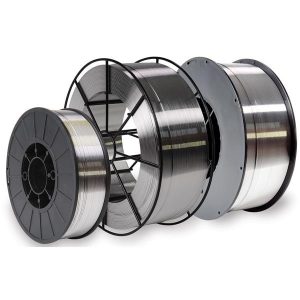
Properly storing your aluminum wire can make a whole lot of difference in terms of its quality. If exposed to the air, aluminum tends to oxidize. So welding aluminum with a compromised wire will result in film coating with more soot coming off as you aluminum weld.
More so, it will create wire feed and electrical resistance and you will have generally difficulty laying down the wire. Inexperienced welders will think that something is worth with their welder and even go as far as changing the spool gun or the contact tips.
But a lot of them tend to forget that improper care of the aluminum wire can also lead to problems. Thus the best way to preserve your wire is to keep in a tightly-sealed container where no air can get in. Keep it away from excessive cold or dampness.
Even by simply moving a cold wire to a warmer place can result in condensation building up inside and damaging the wire further. So keep it in a place where the temperature is stable
Frequently Asked Questions
What does ER4043 stand for?
ER4043, also called AISi5, is one of the types of aluminum filler metals consisting of 5% silicon. It is commonly used for MIG welding aluminum and for the TIG setup. This type of aluminum filler wire is used for 3003, 3004, 5052, 6061, 6063 types but also comes in handy when casing alloy on 43, 355, 356, and 214.
What is the difference between 4043 and 5356 aluminum?
The main difference is that 4043 has 5% silicon added to it, while the aluminum 5356 one has 5% magnesium. These two are the most commonly used filler materials when welding aluminum and in some cases, certain structural elements can be welded by both. But generally speaking, the two are different and a welder should follow the selection chart to determine which one would be used best.
Does welding aluminum weaken it?
When welding aluminum a weld in the aluminum alloy tends to be weaker than the alloy being welded. This is not the case with carbon steel or other types of materials. But when it comes to aluminum a weld cannot be made as strong as the parent material.
Can you weld aluminum to steel?
Welding aluminum to steel is possible, but the process requires different types of techniques to be used. The most reliable way of doing so is through arc welding and friction welding. The biggest problem in welding aluminum to steel is that the materials have different physical properties in terms of metallurgy and also come with different conductivity and melting temperatures.
Conclusion
Keep in mind that aluminum welding by itself is not as easy as you think. One does need to have a steady hand as well as being able to use good technique. But an important factor in successful aluminum welding is the choice of your aluminum wire. Welding thin gauge aluminum or one that is thinner than 14 gauge requires to think hard about the wire you are going to use even though it comes at an extra cost.
Make sure that you have all the pieces of information in regards to the materials that you are working on. That will enable you to choose the correct type of wire. It can greatly influence your final product and make your work a lot cleaner and better. Consider the given aluminum welding wires for your next project.



